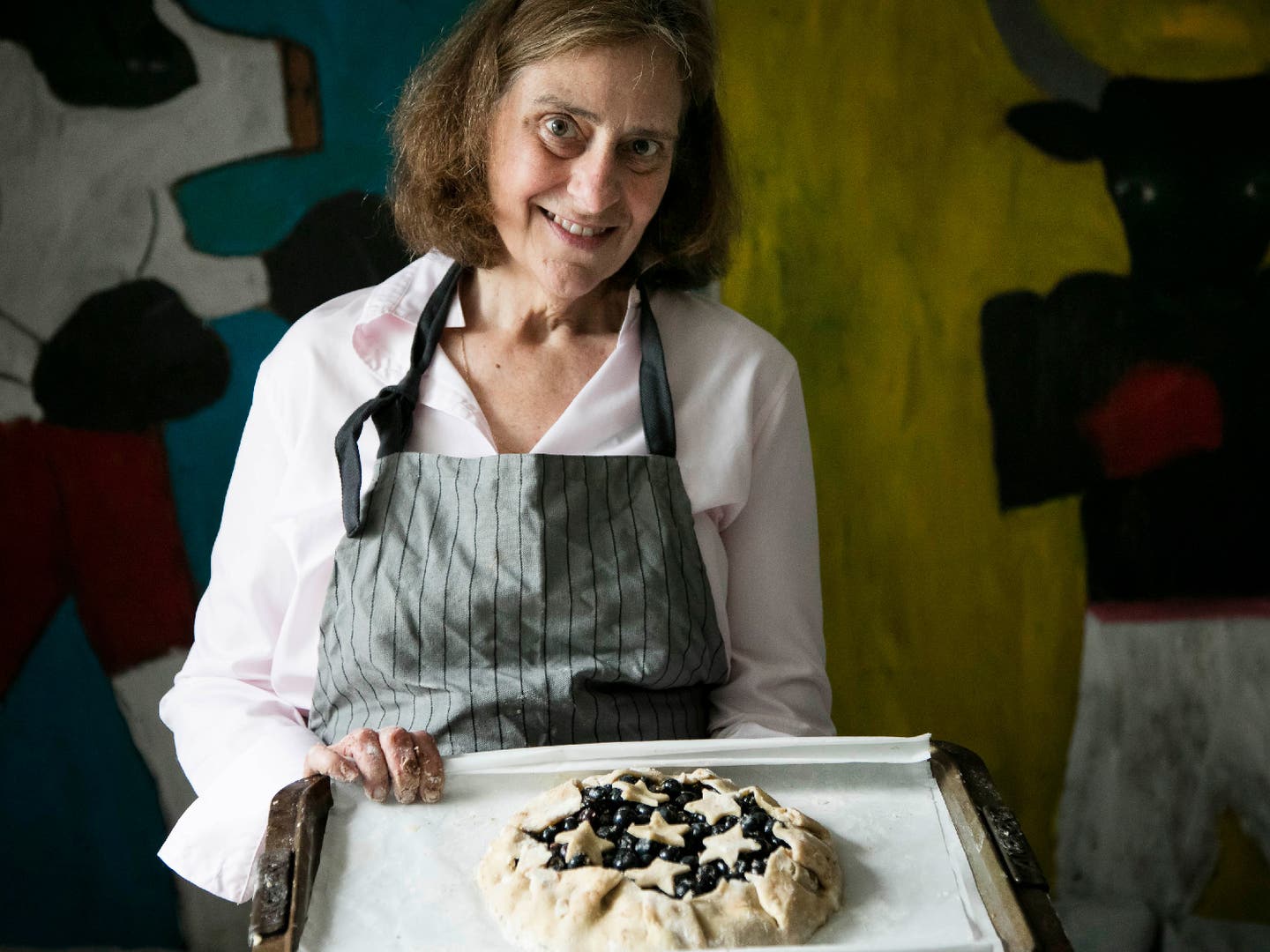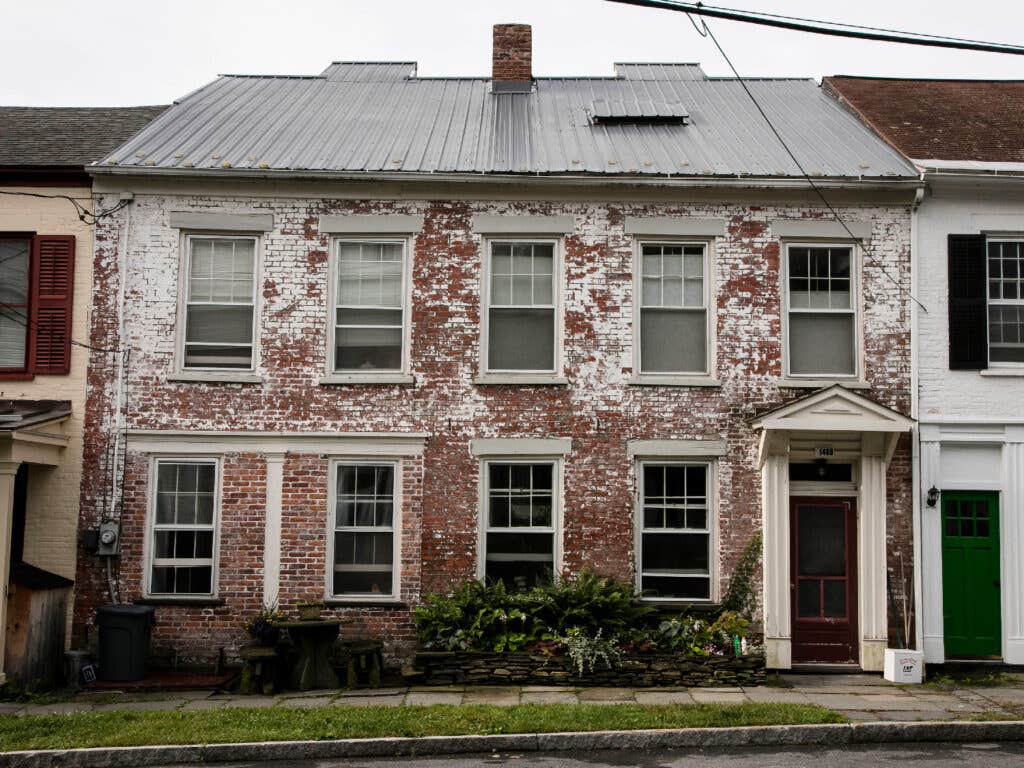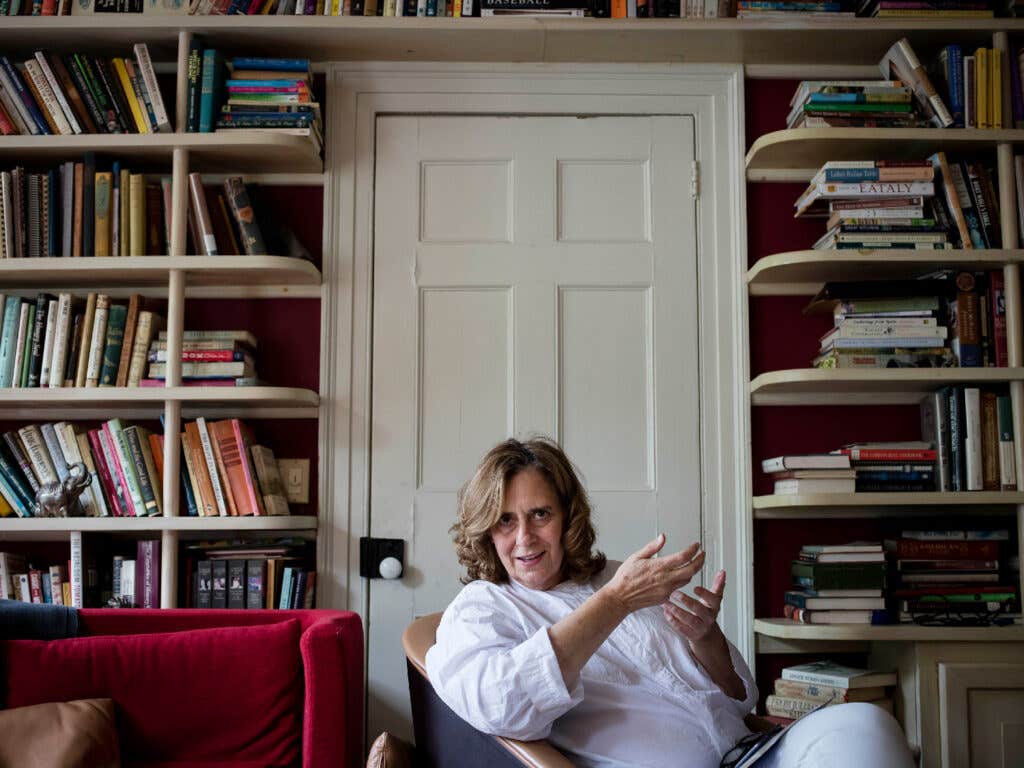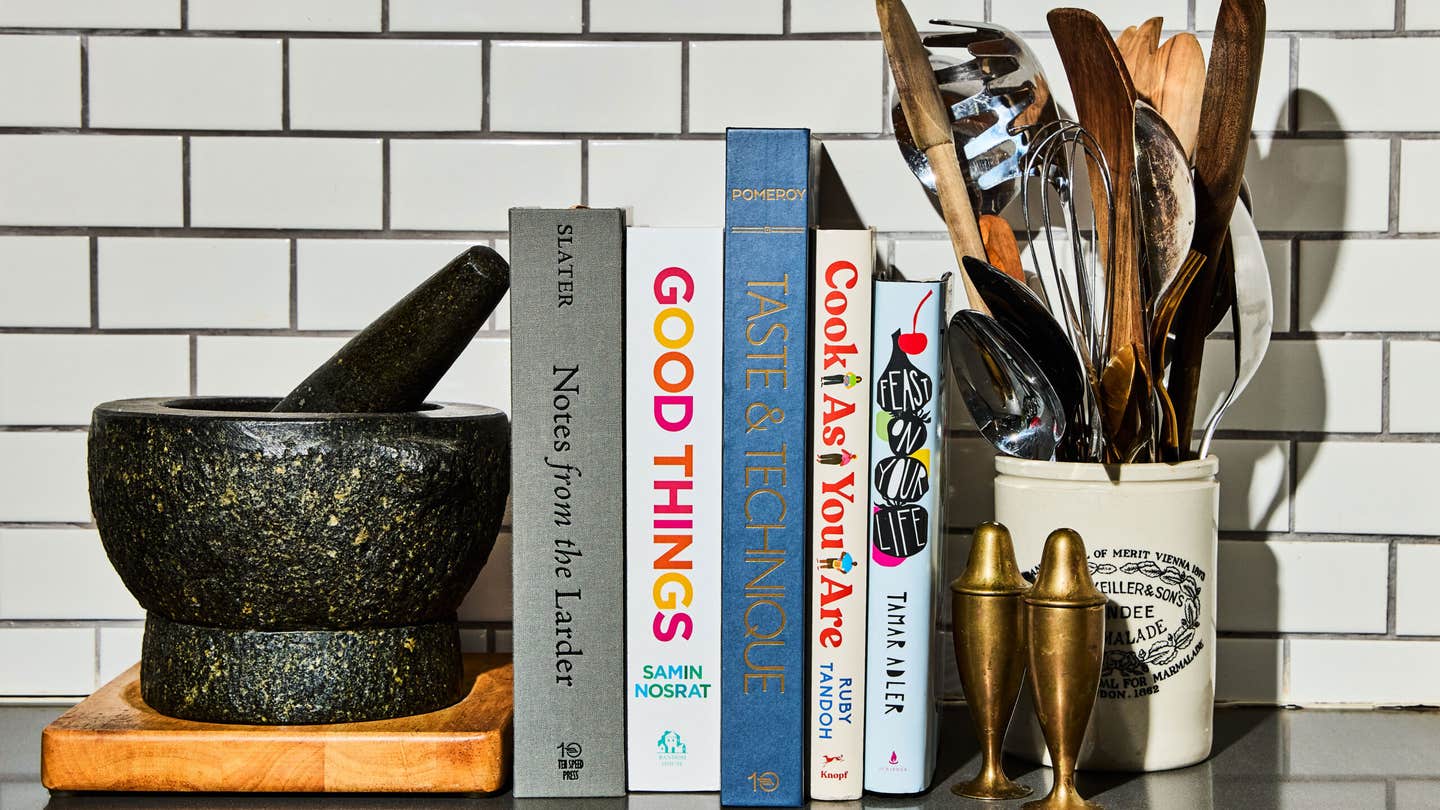
Molly O’Neill Was My Mentor, Boss, and Friend
Celebrating the life and work of one of New York’s most beloved food writers
The first thing I did when I heard earlier this week that my friend Molly O’Neill had died was cry. The second thing I did was scrub my Dutch oven.
A legendary New York Times food writer, a cookbook author, editor, ghost writer, memoirist, teacher, events planner, television host, web pioneer, and contributor to countless publications, including SAVEUR, Molly O'Neill was too busy for fussy housekeeping. LongHouse, her grand home in Rensselaerville in New York's Catskill Mountains, was brimming with folk art and vintage finds. Cookbooks spilled from the shelves and lined staircases. Friends and neighbors barged in at all times. In summer, students overran the place.
In her country kitchen, with its hulking range and its island where she left fruit, mushrooms, and bread heels to dry, shelves bowed under stacks of tableware; jars of local honey and bags of local produce crowded counters; drawers and cabinets were stuffed. It was a scramble to keep up with the dishwashing that followed the constant cooking.
But Molly was fastidious about a few things. She insisted that her knives be washed, dried, and stowed immediately. And she was a stickler for the sparkle on her enamelware. I would often find Le Creuset pots on her stove, boiled water and baking soda working stains from their surface. Their spotlessness was important to the foundation of her cooking. Her freezer filled with gallon containers, Molly was always making stock, pure and concentrated.
So it was with her writing. She was one of the keenest observers of human nature that the food world has been gifted. “I’m fascinated by people’s cooking, but I’m really fascinated by their lives,” she said. What Molly cared about was the emotional foundation—the personal responses to lived experience that made one person’s dish, and one person’s story, so different from another’s. Her writerly attention pure and concentrated, Molly was always taking stock.
In the spring of 2014, Molly took stock of me. I had just left SAVEUR, and she saw in me a potential asset to an enterprise she had dreamed up that combined an online writing school, an immersive residency program for (nearly all women) food writing students, a food festival, and a press. Busy with other things, I was reluctant, but in no time, she lured me upstate and into the free-for-all that was summer at LongHouse.
I started editing the press’s small-format cookbooks. I did a live reporting demo at the festival, LongHouse Food Revival. I taught narrative structure to her summer students. I pinch-hit for her with her online classes. When Molly became ill, I took over as facilitator for a writing residency she had organized at Julia Child’s house in Provence.

Peopled by writers, artists, photographers, chefs, sponsors, farmers and assorted other locals, with Molly’s champion bearded collies underfoot, the proceedings at LongHouse overflowed with art and eats and the student emotions engendered by Molly’s “10-Minute Eggs,” morning writing prompts along the lines of, “Mary had a little lamb and it had a case of separation anxiety. This morning, settle into your chair, set your timer for 10 minutes and let Mary tell you what it felt like to be followed around everywhere she went.”
It felt wholly removed from the world of corporate media that I, and she before me, had left. "Well, it's supposed to be profitable," she told me.
“Oh,” I thought. “Huh.” She meant to make money, but that wasn’t what drove the endeavor. LongHouse was driven by love—for food and writing, and mostly, community. I was coming off 15 years in the holds of the publishing world, where men helmed the ships, and money was the stormy sea we navigated. But beside the placid lake in Rensselaerville, Molly was focused on each woman who held a pen, and on a food community that could support their writing.
She was always a feminist. She came of age during the women's movement, and her first cooking job in 1977 was at the Ain't I a Wommon Club, a Massachusetts collective she co-founded that served "nonviolent cuisine." There were few women at restaurant stoves in the 1980s. As chef at Ciro's in Boston, she garnered enough attention to get a writing gig at The Boston Globe. In 1990, she joined The New York Times. There, she wrote with humor and gravitas about the human spirit and its foibles, including her own.
The description of her move to Manhattan that opens 1992's New York Cookbook, her award-winning compendium of the town's delicious diversity, exemplifies her style.
Forget about the food; if ever was written the experience of a newbie in New York, this is it. But Molly was a quick study. In short order, she was reporting on the city's culinary panoply: Hell's Kitchen's under-the-radar multicultural strip; the pan-Latin food stands at Brooklyn's Red Hook soccer fields—revelations to the largely white, middle-class readers of the Times. She covered fad diets and backlash binges and other national food trends; she wrote portraits of everyone from Gloria Steinem to retired librarian Ellen Burr, winner of the Gilroy Garlic Cook-Off.
She hosted PBS's "Great Food," won James Beard awards, and published three more cookbooks, including One Big Table, a 600-recipe, coast-to-coast celebration of America's "tossed salad" of cuisines, with recipes from both chefs and what she called "the glorious American amateur." Molly was omnivorous and peripatetic because, as she said, "Heck, it's a big country with a big appetite."
"This is the thing she taught me as a reporter," says Dana Bowen, a former executive editor of SAVEUR who worked on Molly's pioneering 1990s food website, also called One Big Table. "If you're curious, and you're willing to say to someone, 'What is that thing you're buying, and what do you plan to do with it?,' you'll be welcomed into their kitchen."
And in their kitchen, you won't just eat; you'll get to know the person behind the meal. My favorite of Molly's stories was published in 2009 in SAVEUR. It is a portrait of Frank Reese, Jr., a Kansas breeder of heritage turkeys. So made was he for his vocation, Molly tells us, that as a first-grader, he wrote a sonnet called "Me and My Turkeys." She visits him at home:
Molly taught her students to carry both a tape recorder for interviews and a notebook for private observations. In this passage, you can see why. The exquisitely wrought details; Reese's raw and idiosyncratic sharing, and the pattern of his speech; the humor and sadness and passion—all of it expresses his humanity. Combine such poetry with a narrative arc that chronicles the rescue of heritage turkey breeds from extinction, and you've got a masterpiece. Teaching at LongHouse and elsewhere, I have always assigned "Rare Breed" to my classes.

It was at LongHouse that I started my third book of poetry. After years of magazine work, it was a return to the foundation of my creativity as a writer. My view of the goldfinches crowding Molly’s neighbor’s plastic bird feeder opens the manuscript. Unlike many in the food world, who assumed that my next book would include recipes or sketches of my culinary travels, Molly understood what I was doing. She had started out as a poet herself. At LongHouse, she broke bread with both poets and food writers. And the poetic details that embody human truths were the ingredients of all her writing, no matter how newsworthy the story was.
Molly had been a creative writer long before she joined newsrooms, so despite her community-building, she craved the solitude that allowed her to write. I worked on poetry at LongHouse in the off season. Alone together in that big building, we didn't see each other all day. At night, we would share a meal. We were in the Catskills; there were local potatoes. I was unhappy with my latkes, but Molly loved them. I wondered if she was uncritical because she wasn't Jewish. But the author of New York Cookbook knew latkes better than I. She had revealed Queens-based food writer David "The Latke King" Firestone's recipe in the book, next to a sidebar on the history of the Lower East Side's Latke Festival.
Molly was a teacher, and she was generous, a trait she claimed she learned from a neighbor in her Boston days, Julia Child. She took stock of me and pointed out some of my foibles, yes, but always moreso my virtues—as a writer and a cook and a woman getting older in this complicated, human world. “You’re reeeally gooood,” she would tell me, drawing out the vowels, lowering her chin to stare at me eagle-like from under big brows. At a time when I was weighing my future, she gave me the confidence to go my own route, make my own latkes, be a poet and a food writer and whatever other kind of writer I wanted to be. She did the same for everyone of whom she took stock. If you flip through her cookbooks, you’ll find that amounts to a heck of a lot of people.
One of the last times I saw Molly was in winter. She was living by then in upper Manhattan, close to the hospital where she needed to go for frequent check-ups and follow-up procedures. She was working on a new memoir about her illness, called Liver: A Love Story. I stopped at Petrossian and bought some of the luxuries she adored: foie gras, smoked salmon. It was during Hanukkah, so I made her latkes, though, by then, she could eat only one or two. I also brought her chicken soup. Preparing the stock with her in mind the day before, I had cleaned my pot well, then dispensed with my own recipe and used hers for 5-hour chicken broth from The New York Times: two birds, two onions, three carrots, three celery ribs, peppercorns, bay leaves, water, and time.
Toward the end of the simmering, I opened my kitchen door and stood at its chilly threshold gazing at my backyard. I thought about another of Molly’s 10-Minute Eggs: “Set your timer for 10 minutes and look out the window. If the naked branches against the sky were bones, what sort of broth would they make? Season it. Simmer it. Sip it and write down every sensation.”
Then I strained my broth through a fine-mesh sieve and set it to cool overnight. In the morning, I skimmed the fat, as per her instructions. I tasted it. The pure and concentrated foundation of my soup, it was a really good stock, indeed.
Keep Reading
Continue to Next Story










